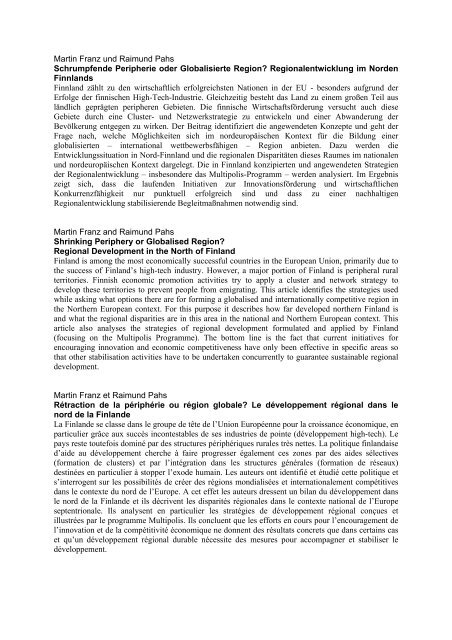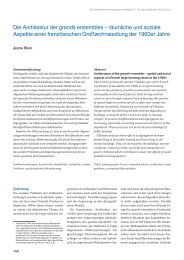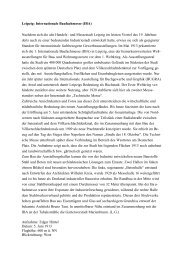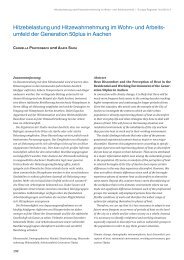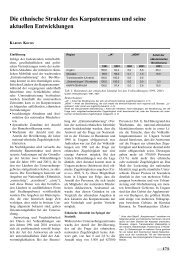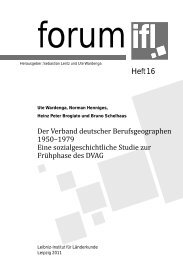Martin Franz und Raimund Pahs Schrumpfende Peripherie oder ...
Martin Franz und Raimund Pahs Schrumpfende Peripherie oder ...
Martin Franz und Raimund Pahs Schrumpfende Peripherie oder ...
You also want an ePaper? Increase the reach of your titles
YUMPU automatically turns print PDFs into web optimized ePapers that Google loves.
<strong>Martin</strong> <strong>Franz</strong> <strong>und</strong> Raim<strong>und</strong> <strong>Pahs</strong><br />
<strong>Schrumpfende</strong> <strong>Peripherie</strong> <strong>oder</strong> Globalisierte Region Regionalentwicklung im Norden<br />
Finnlands<br />
Finnland zählt zu den wirtschaftlich erfolgreichsten Nationen in der EU - besonders aufgr<strong>und</strong> der<br />
Erfolge der finnischen High-Tech-Industrie. Gleichzeitig besteht das Land zu einem großen Teil aus<br />
ländlich geprägten peripheren Gebieten. Die finnische Wirtschaftsförderung versucht auch diese<br />
Gebiete durch eine Cluster- <strong>und</strong> Netzwerkstrategie zu entwickeln <strong>und</strong> einer Abwanderung der<br />
Bevölkerung entgegen zu wirken. Der Beitrag identifiziert die angewendeten Konzepte <strong>und</strong> geht der<br />
Frage nach, welche Möglichkeiten sich im nordeuropäischen Kontext für die Bildung einer<br />
globalisierten – international wettbewerbsfähigen – Region anbieten. Dazu werden die<br />
Entwicklungssituation in Nord-Finnland <strong>und</strong> die regionalen Disparitäten dieses Raumes im nationalen<br />
<strong>und</strong> nordeuropäischen Kontext dargelegt. Die in Finnland konzipierten <strong>und</strong> angewendeten Strategien<br />
der Regionalentwicklung – insbesondere das Multipolis-Programm – werden analysiert. Im Ergebnis<br />
zeigt sich, dass die laufenden Initiativen zur Innovationsförderung <strong>und</strong> wirtschaftlichen<br />
Konkurrenzfähigkeit nur punktuell erfolgreich sind <strong>und</strong> dass zu einer nachhaltigen<br />
Regionalentwicklung stabilisierende Begleitmaßnahmen notwendig sind.<br />
<strong>Martin</strong> <strong>Franz</strong> and Raim<strong>und</strong> <strong>Pahs</strong><br />
Shrinking Periphery or Globalised Region<br />
Regional Development in the North of Finland<br />
Finland is among the most economically successful countries in the European Union, primarily due to<br />
the success of Finland’s high-tech industry. However, a major portion of Finland is peripheral rural<br />
territories. Finnish economic promotion activities try to apply a cluster and network strategy to<br />
develop these territories to prevent people from emigrating. This article identifies the strategies used<br />
while asking what options there are for forming a globalised and internationally competitive region in<br />
the Northern European context. For this purpose it describes how far developed northern Finland is<br />
and what the regional disparities are in this area in the national and Northern European context. This<br />
article also analyses the strategies of regional development formulated and applied by Finland<br />
(focusing on the Multipolis Programme). The bottom line is the fact that current initiatives for<br />
encouraging innovation and economic competitiveness have only been effective in specific areas so<br />
that other stabilisation activities have to be <strong>und</strong>ertaken concurrently to guarantee sustainable regional<br />
development.<br />
<strong>Martin</strong> <strong>Franz</strong> et Raim<strong>und</strong> <strong>Pahs</strong><br />
Rétraction de la périphérie ou région globale Le développement régional dans le<br />
nord de la Finlande<br />
La Finlande se classe dans le groupe de tête de l’Union Européenne pour la croissance économique, en<br />
particulier grâce aux succès incontestables de ses industries de pointe (développement high-tech). Le<br />
pays reste toutefois dominé par des structures périphériques rurales très nettes. La politique finlandaise<br />
d’aide au développement cherche à faire progresser également ces zones par des aides sélectives<br />
(formation de clusters) et par l’intégration dans les structures générales (formation de réseaux)<br />
destinées en particulier à stopper l’exode humain. Les auteurs ont identifié et étudié cette politique et<br />
s’interrogent sur les possibilités de créer des régions mondialisées et internationalement compétitives<br />
dans le contexte du nord de l’Europe. A cet effet les auteurs dressent un bilan du développement dans<br />
le nord de la Finlande et ils décrivent les disparités régionales dans le contexte national de l’Europe<br />
septentrionale. Ils analysent en particulier les stratégies de développement régional conçues et<br />
illustrées par le programme Multipolis. Ils concluent que les efforts en cours pour l’encouragement de<br />
l’innovation et de la compétitivité économique ne donnent des résultats concrets que dans certains cas<br />
et qu’un développement régional durable nécessite des mesures pour accompagner et stabiliser le<br />
développement.
Мартин Франц, Раймунд Пас<br />
Убывающая периферия или глобализированный регион Региональное развитие<br />
в Северной Финляндии<br />
Экономически Финляндия относится к наиболее успешным странам ЕС – в особенности<br />
благодаря достижениям финской промышленности высоких технологий. В то же время страна<br />
представлена в значительной степени сельскими периферийными регионами. В рамках<br />
существующей системы стимулирования финской экономики делается попытка осуществить<br />
хозяйственный подъём этих регионов путём использования стратегии кластерного и сетевого<br />
развития и воспрепятствовать оттоку из них населения. В статье анализируются применяемые<br />
на практике концепции и рассматриваются возможности, возникающие для формирования<br />
глобализированного, т.е. конкурентоспособного в международном отношении региона. Для<br />
этого исследуется развитие Северной Финляндии и региональные диспропорции этой<br />
территории в национальном и северо-европейском контексте. Анализируются стратегии<br />
регионального развития, разработанные и применяемые в Финляндии, в частности программа<br />
Multipolis. В результате оказывается, что задействованные в настоящее время инициативы по<br />
стимулированию инноваций и повышению экономической конкурентоспособности являются<br />
успешными лишь в отдельных случаях и что для достижения устойчивого регионального<br />
развития необходимы сопутствующие стабилизирующие мероприятия.


